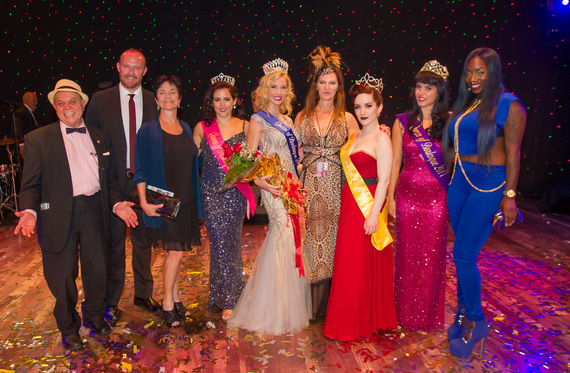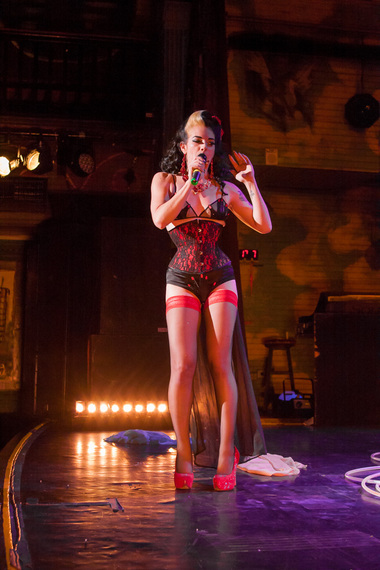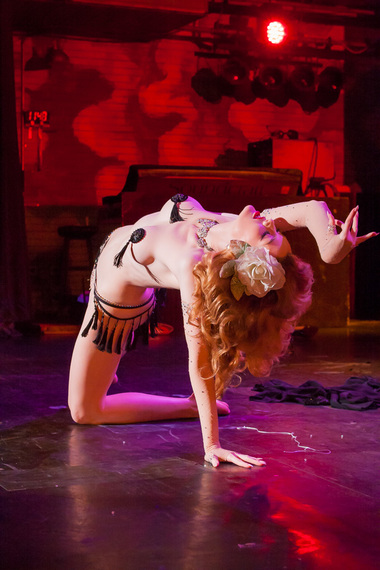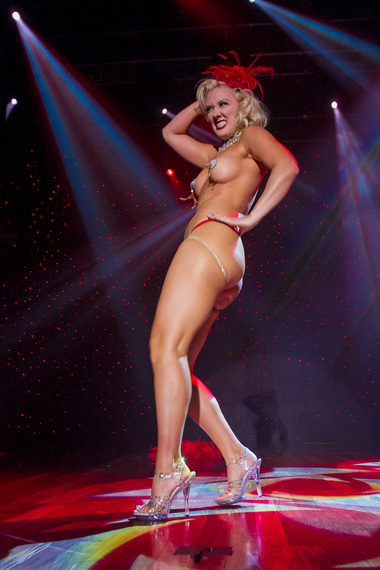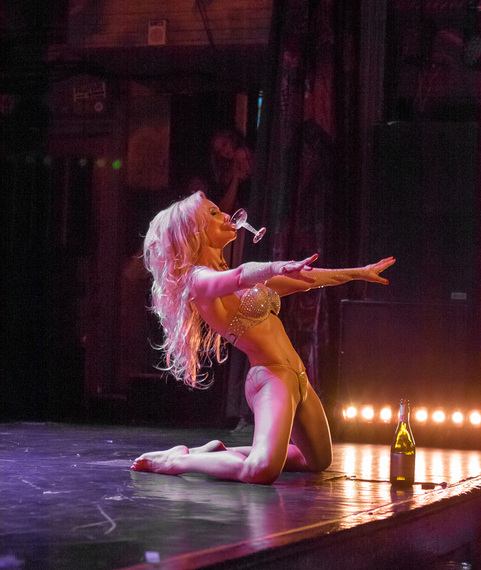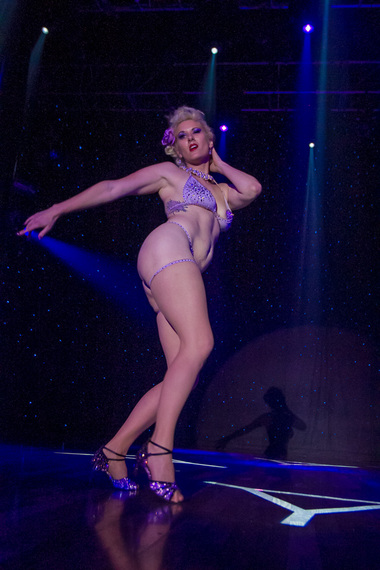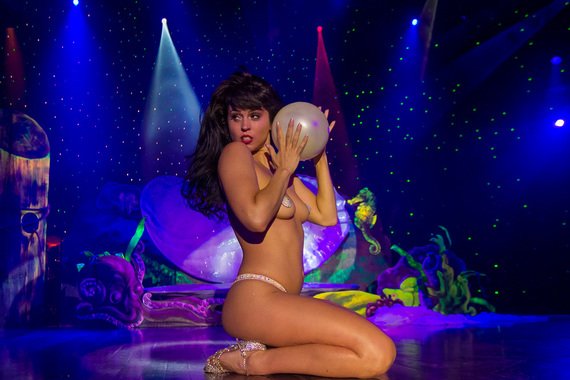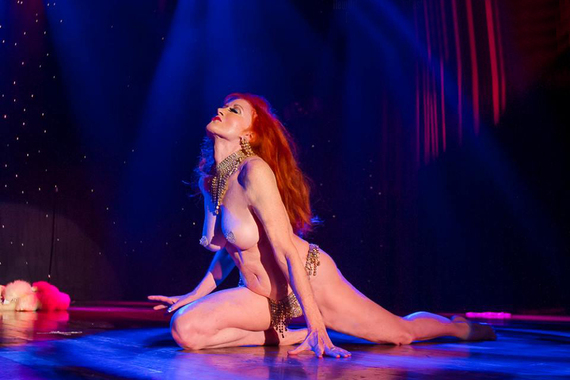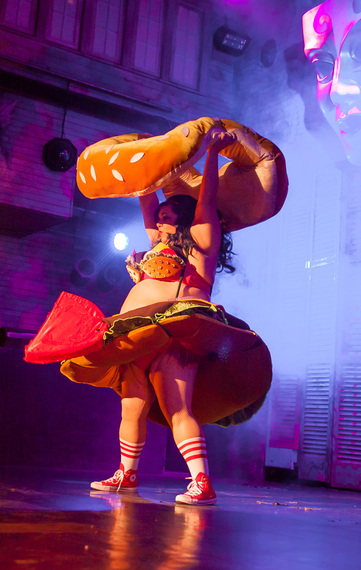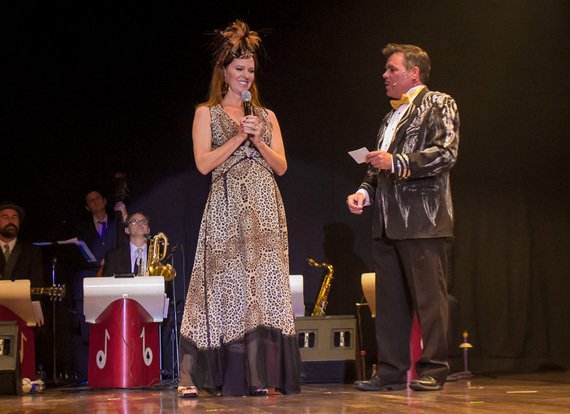I am just back from a weekend as a judge at Rick Delaup's 7th annual New Orleans Burlesque Festival in the Big Easy. I had decided to interview the current crop of burlesque strippers performing over the weekend, which included two nights of performances, four very different shows, a whole lot of boobs, glitter and jaw-dropping feats, including back bends, hand-balancing, hula hooping and trapeze artists. From fifty performers. That's a whole lotta strippin.
I have rarely interviewed the newer generation because my work has been concentrated on documenting the forgotten names from the Golden Era. Now I wanted to peel the layers away from these modern-day performers and learn what burlesque means to them.
Backstage at Harrah's Casino, amongst piles of Glitter Bomb lotion, latex glue, thigh-high fishnets, hair extensions, wigs, lashes, sewing kits, crystal-encrusted panties, g-strings, and much more I spoke to some of the girls. Audrey Ivory, a Canadian performer and makeup artist explained her passion for burlesque started with costumes and the makeup. Burlesque was a way for her to freely express herself. "You can do what you want, and be yourself." For her it was "super empowering." Different from the Golden Era when it was often just making a living. The empowering came later.
As one of the only theatrical art forms where the artist is in complete control of their 5-8 minutes on stage both eras of performers enjoyed near total control of what they did and how they presented it. For example, Lili St. Cyr, the subject of my latest book, passed on a career in movies because she preferred total command of her act. At the fest Dollipop, from California, had two girls strip her while she played various musical instruments to music she wrote. Being able to express one's self seemed a key ingredient to why many of the performers today went into burlesque. Like Blaze, a cherry red-headed dancer. For her it was the expression of her sexual power that hooked her. "So often women are told that they aren't what they should be by society . . . but when onstage it's pretty easy to feel the appreciation for what you are putting out there." And this Blaze and 1950s icon Blaze Starr, like most girls, make the majority of their own costumes. This too I know, as a major collector of historical memorabilia. The girls do their own makeup and hair, find their music, choreograph their numbers.
GoGo Mcgregor, MC at one of the House of Blue shows, a late night and raunchier show than Harrah's, gave up a theatrical career because she didn't like being "stuck" in the theatre doing what others wanted her to do. Burlesque gave her the outlet to combine an interest in lights, costumes and performance. The pencil-thin GoGo, a dead ringer for Daphne Guinness, complete with white streak in hair was sporting a stylish cane due to a dance injury. In burlesque there is no rest. As 1930s star Betty Rowland told me, if you didn't go on there was always someone in the wings ready to take your place. GoGo celebrated the fact that in burlesque she could "do it all." Though many of the girls didn't make a living entirely off burlesque, it was a "passion" and not "a hobby," said MisRed Delicious, from New Zealand. "It saved me," she created it with giving her the "creative freedom" she lacked in her "real life." Miss Miranda, a gorgeous Brit relayed " I had suddenly entered into this artistic, bohemian, hugely open minded world where no one was judged or judging, and everyone was free to be whatever they wanted to be. Seeing these confident, creative, intelligent people express their sexual identity with such beauty and artistry was utterly inspiring."
Minxie Mimieux, a buxom redhead stripper, claimed to be hooked after finding her grandmother's stash of girlie magazines. To her there was no difference between burlesque strippers and "strip club strippers," both used their beauty and their bodies.
Missy Lisa got into burlesque because she thought it would be "fun and sexy . . . cheeky". The girls adored the aesthetic aspect of "the lingerie, the sparkles, the ruffles," said Femme Bruele, who performed a hilarious piece undressing from her hamburger costume. And that is burlesque. Humor and more humor. Another delight was Kiki Cherie who pulled donuts from unexpected - yet clearly expected - places to the roar of the audience.
Burlesque continues to be difficult, relentless work; training, crafting, making and hauling props, rehearsing and searching for work. One performer joked dating a burlesque artist meant the man (or woman) would be living with "glitter up your ass
A strong love of the retro appeals to those today. Rick Delaup says he liked the "naughty, risqué element of it" and that was why he started producing shows. He, like so many, "wanted to step back in time and experience an authentic 1950s show." Another of the MC's, Naughty Pierre, from Colorado explained his love with the old-fashion element. "It takes us back." For "two hours you get to not worry about the trouble of the world." Which is why burlesque thrived during the Great Depression when Broadway struggled. Femme Brulee added, "When someone comes up to me after a show and says `I've had a really bad week. I almost didn't come out tonight, but I'm so glad I did. I haven't smiled that much in a really long time' -- I know I've done my job." Burlesque then and now, is entertainment.
From the other side of the footlights was a similar point of view. One dapper fan of burlesque wearing a smashing suit and a Clark Gable-esque mustache told me it was the retro vibe that appealed to him. As a straight male he liked the "glamour" and "glitz" of the shows and found the women, many now his good friends, "creative and strong." It wasn't "just the sex appeal . . . It's not about the reveal. It's about how they get from A to B and tell a story doing it."
How did the dancers feel about being called strippers? "It is what I do," said Missy Lisa proudly. Maxi Millions, a long-haired blonde felt there was something glorious in the history of stripping from the circus "cooch shows." In burlesque she said, "We get to write our own stories and share them with strangers."
MisRed felt no longer defined by who she was to other people; "mother, wife, daughter." She put her "heart and "soul" into her performance with "no expectation to be other than what she" chose to present to the audience. She was appreciative of the women that went before who "fought for the right" to show their bodies, and championed "for the civil liberties of women." She was going to carry on the tradition.
"It was always a woman's game" said Rita Alexander the former Champagne Girl, who made it big in the 1960s on Bourbon Street (sipping champagne from a glass balanced on her formidable breasts.) Rita was being honored at the festival by newly crowned queen Stormy Gayle who did an astounding recreation of an act Rita invented. In the nearly 15 minute act, Gayle strips to the theme music from "Goldfinger" until she is shot dead by a trench coat-wearing spy. It was a dramatic piece of theatre.
Queen of the Festival, Miss Stormy Gayle in "Gold finger"
photographer: nolapus
This very female-driven industry had provided the girls with family. It was strength, femininity, vintage and nostalgia. I asked GoGo was there a difference with strip club dancers and burlesque dancers. "Very different . . . the intention" is what made the difference. In one, the intention is to make money. In burlesque the intention is having a "creative outlet." The other was a "desperate grasp for money." Burlesquers were performing not because they needed to pay rent or tuition, but because they wanted to be there. There was no "hustling involved" in burlesque explained my Clark Gable-esque friend. Burlesque performers didn't need anything from their audience.
The strippers were a "special group of women," said Missy Lisa. They inspired one another, gave classes, advice, and mentored each other. Sometimes catty, mostly not.
How much did they know or care about the past? "History," said GoGo "is our mother" and "we're paying homage, not copying by adding to it and making burlesque grow." MisRed taught the history in her burlesque classes. "It is an important art form." Audrey Ivory felt it was "important to celebrate the legends." Most of whom are no longer with us. Kitty West, a mainstay on Bourbon Street during the 1950s performing as Evangeline the Oyster Girl, who stripped from an oyster shell was too sick to attend the performance by Ginger Valentine, whom she had mentored. "To know where you're going," explained Delaup, "you've got to know where you've been."
There was another special performance by Stephanie Blake, a woman who got into stripping decades before. Blake gave a performance that garnered a well-deserved standing ovation. A sexy redhead with a killer body, she did backbends, splits, all as naked as the law allowed, and better than most girls half her age. Burlesque was and is a long career.
Empowering, liberating, freedom of expression, they were all things the current crop of dancers clung to. They didn't need to make a living off stripping as the girls in the past did, but found a kinship with the women who disrobed before them. For them burlesque was life saving. They were free. They refuse to be marginalized. They continue to fight for the right to do with their bodies as they chose. Despite body size, race, social background it was their choice to dress (or undress) as they like. To live their lives as glitter-filled as possible. They all embraced their inner - or outer - hamburger and revealed in their power as women.
Rita Alexander was happy to see burlesque back. It had given her a good life and she had many happy times, but there were "some drawbacks too." It was assumed back in the 1960s the girls were "walking on the wild side." Well, weren't they, I had to ask. Rita laughed. "Might be why I liked it."
Additional thanks to Paul Frederick Kowalick, Blaze, Miss Miranda, Elle Dorado, Duchess De Berry and the participants of NOBF 2015.
Leslie Zemeckis is the author of Goddess of Love Incarnate; The Life of Stripteuse Lili St. Cyr, published by Counterpoint Press, out now. Zemeckis wrote "Behind the Burly Q", the definitive history of burlesque and is the director of the award-winning documentary "Bound by Flesh", about Daisy and Violet Hilton of sideshow fame. Her next project is a documentary on legendary tiger trainer Mabel Stark, will be out in 2016. Zemeckis has one of the largest collections of burlesque memorabilia. @Lesliezemeckis, www.lesliezemeckis.com

